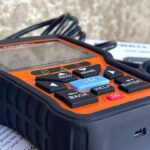Navigating the world of automotive diagnostics can be complex, especially when dealing with classic vehicles like the 1993 Ford Bronco. If you’re diving into troubleshooting or performance tuning, understanding the diagnostic systems is crucial. For owners of the ’93 Bronco, a common question arises: “1993 Ford Codes Obd1 To Obd2 Adapter” – is this the key to modern diagnostics? Let’s explore the diagnostic landscape of your Bronco and clarify the role of OBD adapters.
Understanding OBD1 in Your 1993 Ford Bronco
The 1993 Ford Bronco, a robust and beloved SUV, utilizes an OBD1 (On-Board Diagnostics 1) system. This first-generation system, while functional for its time, is quite different from the OBD2 systems found in vehicles from 1996 onwards.
OBD1 in your Bronco relies on the EEC-IV (Electronic Engine Control IV) computer. Accessing diagnostic codes typically involves using a scan tool specifically designed for OBD1 Ford vehicles, or employing methods like counting check engine light flashes. These codes are essential for pinpointing issues within the engine and related systems.
Image: A classic Ford Bronco, representing the model year 1993 discussed in the article.
The Question of OBD1 to OBD2 Adapters
With the prevalence and accessibility of modern OBD2 scan tools, it’s natural to wonder if an OBD1 to OBD2 adapter can bridge the gap for your 1993 Bronco. These adapters physically change the connector shape to fit an OBD2 scanner. However, it’s crucial to understand their limitations.
While an adapter can allow you to plug an OBD2 scanner into your Bronco’s OBD1 port, it does not magically convert the diagnostic protocol. OBD2 scanners are designed to communicate using different protocols than OBD1. Therefore, simply using an adapter with a generic OBD2 scanner is unlikely to provide accurate or comprehensive diagnostic information for your 1993 Ford Bronco.
Effective Diagnostic Approaches for Your 1993 Bronco
So, if an OBD1 to OBD2 adapter isn’t the ideal solution, what are the recommended approaches for diagnosing your 1993 Bronco?
-
OBD1 Scan Tools: The most reliable method is to use a scan tool specifically designed for OBD1 Ford vehicles and EEC-IV systems. These tools are capable of correctly interpreting the diagnostic codes and data from your Bronco’s computer. While they might be less common than OBD2 scanners, they are the proper tools for the job.
-
Manual Code Reading: For basic diagnostics, you can utilize the “check engine light flash” method. This involves putting the EEC-IV system into diagnostic mode and counting the flashes of the check engine light to decipher trouble codes. This method requires a code chart specific to 1993 Ford OBD1 systems.
-
Professional Mechanics: For complex issues or if you prefer expert assistance, a mechanic familiar with classic vehicles and OBD1 systems is invaluable. They will have the necessary tools and knowledge to accurately diagnose and repair your Bronco.
Image: A garage setting, symbolizing the context of car repair and diagnostics discussed in the article.
Important Safety Recall for 1993 Broncos
Beyond diagnostics, it’s vital for 1993 Ford Bronco owners to be aware of a significant safety recall related to the speed control (cruise control) system. Some vehicles were repaired with an incompatible wiring harness, potentially leading to an electrical short and underhood fire.
Actionable Steps:
- Check Recall Completion: Verify if the recall work on your Bronco has been completed by a dealership.
- Inspect Wiring Harness: Look for the updated harness with two fuses instead of one, indicating the recall was addressed.
- Consult a Dealer: If you are unsure, contact a Ford dealership to check your VIN and confirm recall status.
This safety check is paramount for all 1993 Bronco owners to ensure vehicle safety and prevent potential hazards.
Conclusion: Diagnosing Your 1993 Ford Bronco Effectively
While the idea of using a “1993 ford codes OBD1 to OBD2 adapter” might seem like a convenient shortcut, it’s not a reliable solution for accurate diagnostics. For your 1993 Ford Bronco, sticking to OBD1 compatible tools or manual methods is the most effective approach. Remember to prioritize safety by checking the cruise control recall and ensure your classic Bronco remains both enjoyable and reliable for years to come.
For further discussions, troubleshooting tips, and connecting with fellow Bronco enthusiasts, online forums and communities dedicated to Ford Broncos are excellent resources.
